Indian Economy 1950-1990 Class 12 Economics
Introduction
- Following India's independence, the country's leaders had to make a decision on which economic system would serve the welfare of all its citizens.
- The two options available were capitalism and socialism.
- Although Jawaharlal Nehru was drawn towards socialism, he didn't want to adopt the Soviet Union's version, which had excessive government control and wasn't suitable for a democratic nation like India.
- Therefore, the leaders opted for a mixed economy system that combined the best aspects of both capitalism and socialism, and this system has been widely adopted by many countries worldwide.
- This choice was reflected in the 'Industrial Policy Resolution' of 1948 and the Directive Principles of State Policy in the Indian constitution.
- To oversee India's development plans, a Planning Commission was established, headed by the Prime Minister, but in 2014, it was dissolved, and the NITI Aayog was created in its place by a cabinet resolution.
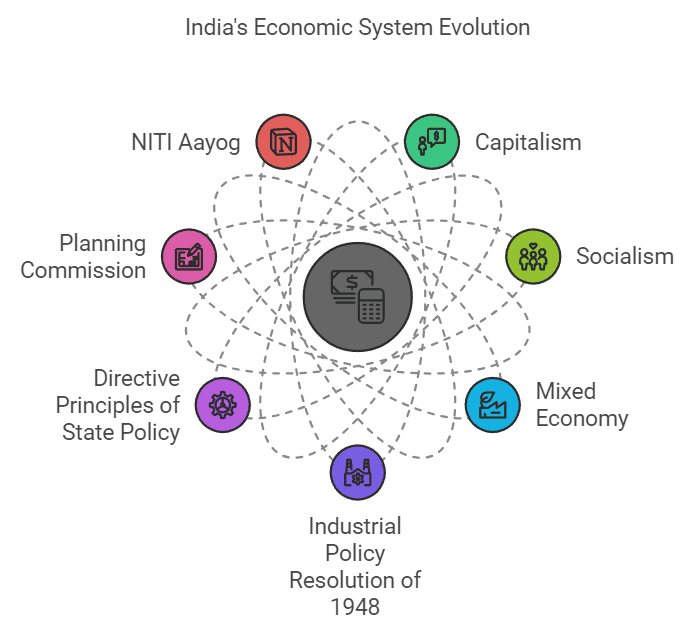
What is a Plan?
- An economy's utilization of resources is planned through a set of defined goals, both general and specific, to be achieved within a particular time frame. In India, the idea of planning was adapted from the former USSR, with a focus on five-year plans that outlined the vision for the next 20 years, referred to as the "Perspective Plan."
- Balancing the goals of the plan is crucial, as modern technology may lead to a reduction in labour employment, and Indian planners had to carefully design the plans to avoid conflicts in development goals. Prasanta Chandra Mahalanobis, a statistician who established the Indian Statistical Institute (ISI) in Kolkata and published the journal "Sankhya," is widely considered to be one of the key architects and formulators of Indian planning.
Goals of the FYPs
- Growth
- Modernization
- Self Reliance
- Equity
When limited resources are available, planners must make choices and prioritize certain goals over others, and not all goals can receive equal importance. However, they must also ensure that the chosen goals do not contradict each other.
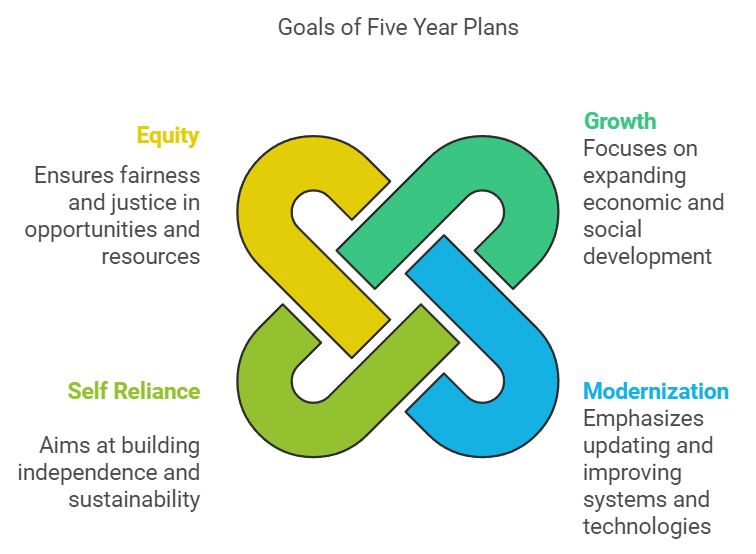
Growth
To improve a country's ability to produce goods and services, it is essential to enhance its capital stock, as well as provide better support services like transportation and banking. The gross domestic product (GDP) is a reliable indicator of a country's growth, calculated as the final value or market value of all goods and services produced within its borders. The GDP is derived from various sectors of the economy, namely agriculture, industry, and services, and the contribution of each sector determines the structural composition of the economy.
Modernisation
The process of modernization involves the adoption of new technology and techniques to enhance productivity, as well as a shift in social outlook towards gender equality and equal rights for all sections of society.

Self Reliance
- To decrease reliance on foreign goods, it is advisable to refrain from importing items that can be produced domestically.
- India had recently gained independence from foreign rule and was unwilling to jeopardize its independence by yielding to external pressure.
- The initial 7 Five-Year Plans of India emphasized the advancement of self-sufficiency, particularly in the food sector, which culminated in the Green Revolution that guaranteed self-reliance in the production of food grains.
Equity
- Ensuring that all members of an economy have an equal share of the advantages of development is crucial.
- A fair allocation of income and opportunities can reduce the number of people living in poverty, enabling them to meet their fundamental requirements while also decreasing income inequality.
Stages of Development
- During the initial stages of development, the economy is generally reliant solely on natural resources, making the primary sector the most crucial. However, as better farming techniques and high-yield varieties of seeds are developed, the primary sector's production has increased with fewer individuals required to work in this sector.
- Those who previously worked in agriculture began to work as artisans, soldiers, and traders of their products, such as wine and pottery, due to modern technology and the Industrial Revolution. There was an increase in the number of people working in factories, and as a result, the secondary sector became important.
- Over the last century, technology has continued to advance, resulting in the creation of new jobs in the service sector. As a result, in developed nations, the majority of individuals are employed in the service sector nowadays.
For Agriculture Development
Indian policymakers were tasked with tackling equity, growth, modernization, and self-reliance issues in agriculture. To bring about a revolution in Indian agriculture, they concentrated on land reforms and the adoption of high-yield variety (HYV) seeds.
- Reforms pertaining to land ownership and usage.
- Elimination of intermediaries and the Zamindari and Jagidari systems, where landlords merely collected rent and did little to improve the conditions of farmers, resulted in 200 lakh tenants coming into direct contact with the government and being freed from exploitation by Zamindars.
- A change in landholding ownership to the tiller, providing them with an incentive to invest in improving agricultural productivity.
- The imposition of a land ceiling to promote equity, which establishes the maximum size of land an individual may own, thereby reducing the concentration of land in the hands of a few.
Issues in the Successful Implementation of Land Reforms
- In certain regions, former Zamindars exploited loopholes in the land ceiling legislation to retain ownership of significant parcels of land.
- They exploited the delay to register the lands in their names or those of their relatives, thus exploiting weaknesses in the system.
- Several prominent landlords also challenged the legislation in court, resulting in delays in its implementation.
- Some Zamindars asserted themselves as legitimate tillers of the land.
The success of land reforms in Kerala and West Bengal can be attributed to the governments' unwavering dedication to the principle of land redistribution to the tiller. Regrettably, other states lacked the same level of commitment, resulting in substantial disparities in land ownership that persist to this day.
Green Revolution

- The success of India's agriculture is closely tied to the monsoon season, and if the monsoon failed, farmers would face difficulties, unless they had access to irrigation facilities, which were not widely available. However, the introduction of the Green Revolution brought an end to this stagnation.
- The term denotes a significant increase in food grain production that arose from:
- The utilization of high-yielding variety (HYV) seeds, particularly for rice and wheat.
- The use of these seeds necessitated the appropriate application of fertilizers and pesticides, as well as a consistent water supply.
- In order to reap the benefits of HYV seeds, farmers needed dependable irrigation facilities and financial resources to buy fertilizers, pesticides, and insecticides.
- Consequently, during its initial phase, the Green Revolution was restricted to wealthy farmers in affluent states such as Punjab, Andhra Pradesh, and Tamil Nadu.
- In the second phase of the Green Revolution (mid-1970s to mid-1980s), the HYV technology spread to a greater number of states and improved the yield of a more extensive variety of crops.
- The Green Revolution's proliferation enabled India to achieve self-sufficiency in crop production, and we no longer relied on other nations for our food requirements, particularly for rice and wheat.
- The excess food was now sold in the market, contributing to the country's economic output. The portion of agricultural produce sold by farmers in the market is known as the marketed surplus.
- During the Green Revolution period, a significant portion of the rice and wheat produced (as marketed surplus) was sold in the market by farmers. Consequently, the cost of food grains declined compared to other consumption items.
- This reduction in relative prices benefited low-income groups, who spend a significant portion of their income on food.
- The Green Revolution enabled the government to accumulate a sufficient amount of food grains for use in times of food scarcity.
- While the country benefited greatly from the Green Revolution, the technology used was not without risks.
- One such danger was the possibility of exacerbating the disparities between small and large farmers since only wealthy farmers could afford the necessary inputs, thus gaining most of the Green Revolution's advantages.
- Furthermore, HYV crops were more susceptible to pest attacks, and small farmers who adopted this technology could lose everything in the event of an infestation.
- Fortunately, the government took steps to alleviate these fears.
- The government provided low-interest loans to small farmers and subsidized fertilizers so that they could also have access to the necessary inputs.
- As a result, the Green Revolution benefited both small and wealthy farmers, and the risk of small farmers being ruined during pest attacks was substantially reduced by the services provided by research institutes established by the government.
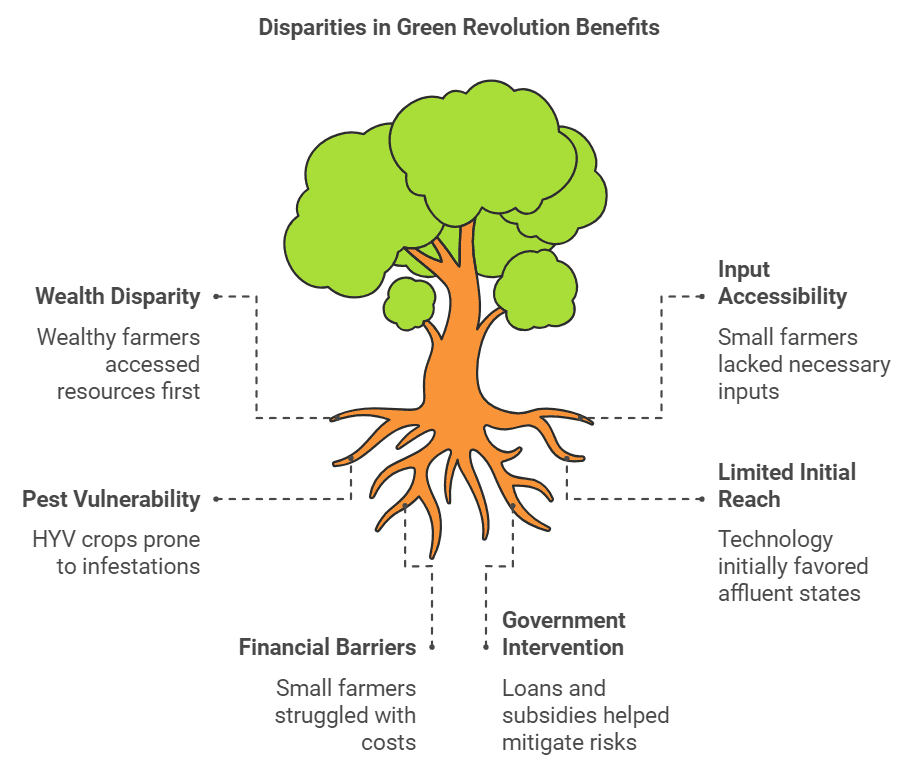
The Debate Over Subsidies
- It is widely acknowledged that subsidies were necessary to provide farmers, particularly small farmers, with an incentive to adopt the new HYV technology.
- Subsidies were required to encourage farmers to experiment with the new technology. However, some economists believe that once the technology has been found to be profitable and has been widely adopted, subsidies should be phased out since their purpose has been fulfilled.
- Moreover, while subsidies are intended to benefit farmers, a significant portion of the fertilizer subsidy also benefits the fertilizer industry, and among farmers, the subsidy primarily benefits those in more prosperous areas.
- As a result, it is argued that there is no justification for continuing fertilizer subsidies since they do not benefit the intended group and place a substantial burden on government finances.
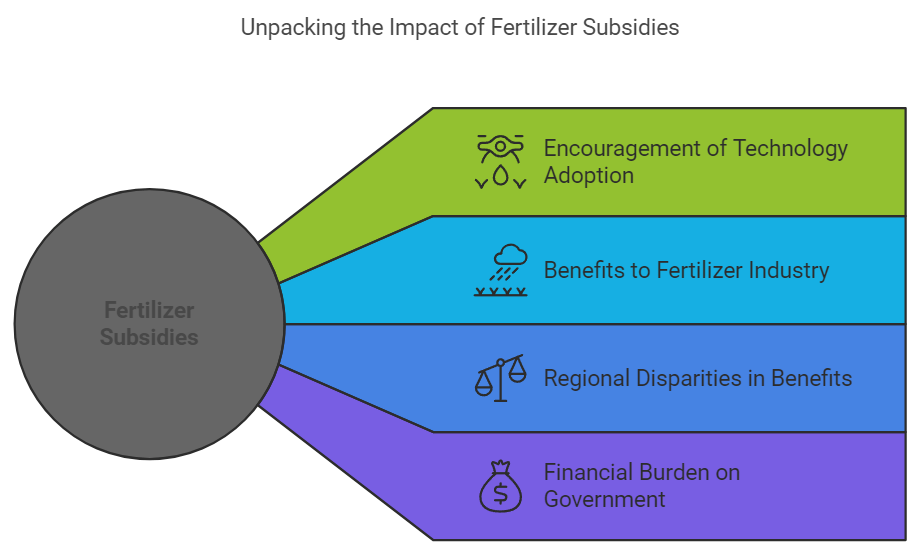
In Favour of Subsidies
- Conversely, there are those who argue that the government should maintain agricultural subsidies because farming in India remains a risky and uncertain endeavour.
- The majority of farmers are impoverished and cannot afford the necessary inputs without subsidies. Eliminating subsidies would widen the gap between wealthy and poor farmers and contradict the goal of promoting equity.
- By the late 1960s, Indian agricultural productivity had increased sufficiently to achieve self-sufficiency in food grain production. However, by as late as 1990, around 65% of the population was still employed in agriculture, indicating a potential negative aspect of this achievement.
- Economists have observed that as a nation grows wealthier, the proportion of GDP contributed by agriculture, as well as the percentage of the population engaged in the sector, declines significantly.
- In India, between 1950 and 1990, the proportion of GDP contributed by agriculture declined substantially, but the percentage of the population dependent on it decreased only marginally, from 67.5% in 1950 to 64.9% in 1990.
Industry and Trade
According to economists, the development of a robust industrial sector is crucial for the progress of underdeveloped nations. This is because industry provides relatively stable employment compared to agriculture and drives modernization, leading to overall prosperity. As a result, industrial development is given significant importance in the five-year plans.
Public and Private Sectors in Indian Industrial Development
- At the time of India's independence, industrialists lacked the necessary capital to invest in the development of the country's economy.
- Furthermore, the market was underdeveloped and not large enough to incentivize industrialists to undertake significant projects, even if they had the capital to do so.
- As a result, the state had to play a crucial role in promoting the growth of the industrial sector.
- Moreover, the decision to pursue socialist policies for economic development led to the state's policy of controlling the commanding heights of the economy, as outlined in the Second Five-Year Plan.
- This policy meant that the state would have complete control over industries that were vital to the economy and that the private sector's policies would need to be complementary to those of the public sector, with the latter leading the way.

Industrial Policy Resolution 1956 (IPR 1956):
- The adoption of the Industrial Policy Resolution of 1956 was in line with the objective of the state to have control over the major industries of the economy.
- The Second Five-Year Plan aimed to establish the foundation for a socialist society and was based on the principles outlined in the Industrial Policy Resolution of 1956.
Features of the Industrial Policy Resolution of 1956 were:
- Industries were categorized into three schedules based on the role of the state, as part of a new classification system. The first schedule, Schedule A, comprised 17 industries that were deemed the sole responsibility of the state for future development.
- The second schedule, Schedule B, included 12 industries where the private sector could support the efforts of the public sector, but the state would have the exclusive responsibility for initiating new units. The third schedule, Schedule C, included all other residual industries that were left open to the private sector.
Stress on the role of cottage and small-scale industries.
- Private sector industries were required to obtain government licenses in order to operate, as per the industrial licensing policy.
- The government also offered industrial concessions to private entrepreneurs who wished to establish businesses in underdeveloped regions of the country. These concessions included tax rebates and reduced rates for power supply.
- While there were certain industries that were left to the private sector, they were still subject to government control through the licensing system. Without a license, no new industry could be established. This policy was particularly focused on promoting industry in economically underdeveloped areas, and obtaining a license was easier for businesses located in such regions. Additionally, these businesses were granted certain benefits, such as tax breaks and reduced electricity tariffs, in order to promote regional equality.
Small-Scale Industry
- A small-scale industry is defined based on the maximum investment allowed on its assets. This limit has been revised over time. In 1950, a small-scale industrial unit was one that invested a maximum of five lakhs rupees. Currently, the maximum investment allowed is five crore rupees, a significant increase from 25 lakhs.
- Small-scale industries are thought to be more labour-intensive than large-scale industries and therefore generate more employment. However, they cannot compete with larger firms, and thus, their development requires protection from them. To achieve this, the production of certain goods was reserved for small-scale industries based on their ability to manufacture them. They were also given concessions such as lower excise duty and bank loans at lower interest rates.

Trade Policy: Import Substitution
- Our adopted industrial policy was closely linked to the trade policy.
- During the first seven plans, trade was characterized by an inward-looking trade strategy, commonly referred to as import substitution, where the aim was to replace imported goods with domestic production.
- The government protected domestic industries from foreign competition.
- Protection from imports took the form of tariffs and quotas.
- Tariffs refer to taxes on imported goods, which make imported goods more expensive and discourage their use.
- Quotas specify the quantity of goods that can be imported.
- Tariffs and quotas restricted imports and protected domestic firms from foreign competition.
- This protection policy was based on the idea that industries in developing countries could not compete against those produced by more developed economies.
- It was assumed that if domestic industries were protected, they would eventually learn to compete.
Effect of Policies on Industrial Development
- India's industrial sector made impressive achievements during the first seven plans.
- The industrial sector's contribution to GDP increased from 11.8% in 1950-51 to 24.6% in 1990-91, indicating significant progress.
- The sector's annual growth rate of 6% during this period is noteworthy and reflects positive development.
- The industrial sector's diversification beyond cotton textiles and jute is attributed largely to the public sector, which helped to establish a wider range of industries by 1990.
- The promotion of small-scale industries provided opportunities for entrepreneurs who lacked the capital to start larger enterprises.
- Protection from foreign competition played a key role in facilitating the development of indigenous industries, particularly in areas such as electronics and automobiles, which may not have been possible otherwise.
Issues with Public Enterprises
- Despite the public sector's contribution to the growth of the Indian economy, many economists have criticized the performance of several public sector enterprises.
- The criticism stems from the fact that during four decades of planned development, no distinction was made between the tasks that the public sector alone could handle and those that could also be handled by the private sector.
- Many public sector firms incurred massive losses but continued to function because it is challenging to shut down a government-run business, even if it drains the nation's limited resources.
- This does not imply that private firms are always profitable. However, a private company that is losing money will not waste resources by continuing to operate despite the losses.
- Industrialists took advantage of the need to obtain a license to start a new company by using it to prevent competitors from starting new firms.
- Permit License Raj: The excessive regulation of the permit license raj prevented some companies from becoming more efficient. Industrialists spent more time trying to obtain a license or lobbying the relevant ministries instead of focusing on improving their products.
- Protectionism is also criticized because it continued even after it proved to do more harm than good.
- Restrictions on imports resulted in fewer choices for Indian consumers, who had to buy whatever Indian producers offered. The producers, aware that they had a captive market, had no incentive to improve the quality of their goods.
- Some economists argue that the public sector is not intended to earn profits but to promote the welfare of the nation.
- These economists believe that public sector companies should be evaluated based on the extent to which they contribute to the welfare of the people rather than the profits they generate.
- Regarding protectionism, some economists argue that we should protect our producers from foreign competition as long as wealthy countries continue to do so. Due to these conflicts, economists have called for a change in policy.
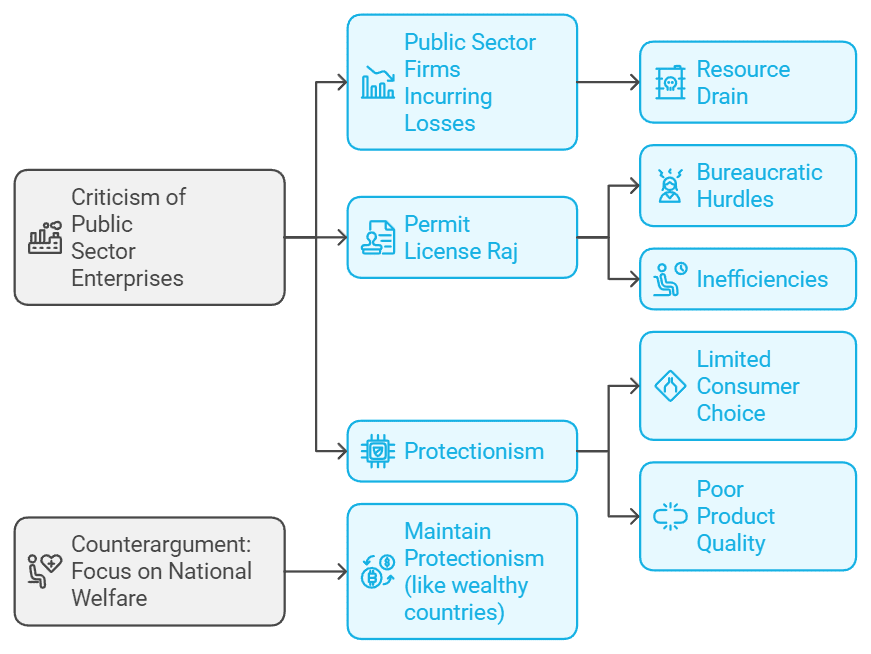
Conclusion
- The Indian economy made impressive progress during the first seven plans, as seen in the increased diversification of our industries compared to the situation at independence. The Green Revolution enabled us to become self-sufficient in food production, and land reforms abolished the zamindari system. However, many economists were dissatisfied with the performance of public sector enterprises, and excessive government regulation hindered the growth of entrepreneurship.
- In the name of self-reliance, our producers were shielded from foreign competition, which did not incentivize them to improve the quality of their goods. Our policies were inward-oriented, resulting in a weak export sector. Given the changing global economic scenario, there was widespread recognition of the need for economic policy reform, and the new economic policy was introduced in 1991 to improve the efficiency of our economy.
|
64 videos|308 docs|51 tests
|
FAQs on Indian Economy 1950-1990 Class 12 Economics
| 1. What are the goals of the FYPs? |  |
| 2. What are the stages of development for agriculture? |  |
| 3. What is the Green Revolution? |  |
| 4. What is import substitution in trade policy? |  |
| 5. What are the issues with public enterprises? |  |






















